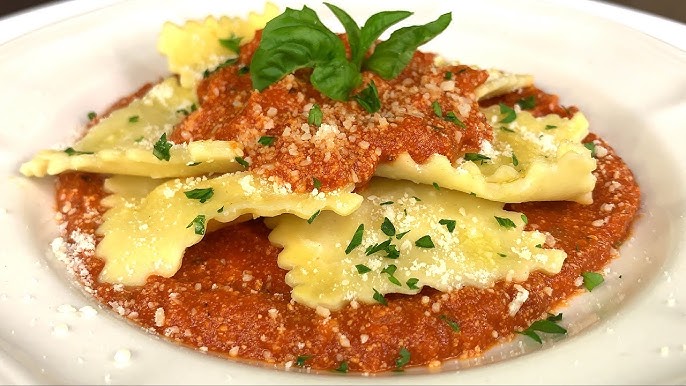Ravioli Sauce Recipe: Ravioli is one of those Italian dishes that feels fancy but is surprisingly simple at its core. It’s basically a filled pasta—little pillows of goodness stuffed with cheese, meat, vegetables, or even seafood. Think of it like the Italian version of dumplings. The outside is soft pasta dough, usually made from flour and eggs, while the inside bursts with flavor, depending on the filling you choose.
This classic comfort food has been around for centuries and is beloved across the globe. But here’s the catch: while the filling matters, what really makes or breaks a ravioli dish is the sauce you pour on top. It’s not just a topping—it’s an essential partner. A well-made sauce enhances every bite of ravioli, binding flavors and adding depth. Whether it’s a rich tomato sauce, creamy Alfredo, or a light garlic butter drizzle, the right sauce can elevate ravioli from simple to stunning.
The beauty of ravioli lies in its versatility. You can make it hearty or light, indulgent or healthy. And just like choosing the right wine for a meal, choosing the right sauce for your ravioli makes all the difference.
Why the Right Sauce Matters
You’ve spent time choosing or making the perfect ravioli filling—cheesy, savory, maybe even a little herby. But serve it with the wrong sauce, and you risk overpowering or even clashing with the flavors. The sauce isn’t just a sidekick—it’s the co-star of your meal.
Think about this: creamy Alfredo sauce on spinach ravioli? Heavenly. But that same sauce on lobster ravioli? Maybe not the best choice. Pair a light butter sage sauce instead, and you’ve got a gourmet dish. The sauce’s richness, acidity, and texture all play key roles in balancing the ravioli.
Also, let’s not ignore texture. Ravioli has a tender bite, so a chunky, overly thick sauce can be distracting. You want a smooth, cohesive coating that clings to the pasta without drowning it. A sauce that complements the ravioli brings out the best in every bite—highlighting rather than hiding the filling.
So yes, choosing the right sauce isn’t just a culinary suggestion—it’s essential. Get it right, and you’ll be making restaurant-quality dishes at home.
Ingredients You’ll Need
Core Ingredients for a Classic Tomato-Based Sauce
Let’s start with the timeless favorite: tomato-based ravioli sauce. This is perfect for cheese-filled ravioli or hearty meat-stuffed varieties. Here’s what you’ll need:
- Olive Oil – Acts as the base for sautéing aromatics.
- Garlic – Finely chopped or minced for that punchy, savory note.
- Onion – Diced small; yellow or white onions work great.
- Canned Crushed Tomatoes – Choose a good-quality brand for the richest flavor.
- Tomato Paste – Adds depth and thickness.
- Dried Oregano and Basil – The classic Italian herbs for bold flavor.
- Red Pepper Flakes (optional) – For a touch of heat.
- Salt & Black Pepper – To taste.
- Sugar – Just a pinch to balance the acidity of the tomatoes.
- Fresh Basil – Chopped for garnish and a fresh finish.
This sauce brings a balance of acidity, sweetness, and herby undertones—ideal for cutting through the richness of cheese ravioli or enhancing the savory notes in meat ravioli.
Ingredients for a Creamy Alfredo Sauce
If you’re leaning toward indulgence, a creamy Alfredo sauce is a luxurious companion to your pasta. Here’s what goes into this luscious white sauce:
- Butter – Unsalted, for that smooth, rich base.
- Heavy Cream – Full-fat for a creamy consistency.
- Garlic – Minced finely for subtle flavor.
- Parmesan Cheese – Freshly grated, not the pre-shredded kind.
- Salt & White Pepper – For seasoning without overpowering.
- Nutmeg (optional) – Just a pinch to enhance the creamy richness.
- Parsley – Chopped, for garnishing.
This sauce works beautifully with mushroom ravioli or even seafood-stuffed types. It’s decadent, silky, and clings to pasta like a dream.
Optional Add-Ons to Elevate Flavor
Want to add your own twist? Here are a few extras to consider:
- White Wine – Add a splash to deglaze your pan for a deeper flavor.
- Sun-Dried Tomatoes – For a sweet, chewy texture in tomato sauces.
- Crushed Walnuts or Pine Nuts – Perfect for pesto-style sauces.
- Chili Oil – Drizzle for heat and aroma.
- Lemon Zest – Brightens up creamy or pesto sauces.
These additions let you tailor your sauce to suit your mood, your ravioli, or even just what you have in your fridge.
Kitchen Tools and Equipment
Basic Tools Required
To make any good ravioli sauce, you don’t need a gourmet kitchen. Just some solid essentials:
- Medium Saucepan or Skillet – Your main cooking vessel.
- Wooden Spoon or Silicone Spatula – For stirring without scratching pans.
- Chef’s Knife – To chop your aromatics with ease.
- Cutting Board – Preferably non-slip for safety.
- Measuring Spoons & Cups – Accuracy matters, especially in seasoning.
A good saucepan with even heat distribution makes all the difference when simmering your sauce. Avoid using nonstick pans with metal utensils—that’s a fast track to ruined cookware.
Helpful but Optional Kitchen Gadgets
If you like your kitchen a little more high-tech or you’re a frequent cook, these tools might come in handy:
- Garlic Press – For a quick and easy garlic mince.
- Microplane – Ideal for grating parmesan or zesting lemons.
- Immersion Blender – Great for smoothing out chunky sauces.
- Food Processor – Especially helpful for pesto or nut-based sauces.
- Ladle or Sauce Spoon – For portioning sauce over ravioli.
You don’t need these, but once you try them, it’s hard to go back.
Prepping the Ingredients
Chopping, Mincing, and Measuring
Before you heat a pan, let’s get everything prepped. This is the key to a smooth cooking experience. Chefs call it “mise en place”—everything in its place.
- Chop onions finely so they melt into the sauce.
- Mince garlic with a knife or press—don’t use pre-minced if you can avoid it.
- Grate your cheese fresh—it melts better and tastes way better than bagged.
- Measure herbs and spices in advance, especially dried ones.
- Open canned tomatoes and have them ready, with the tomato paste nearby.
When you’re working with a hot pan, there’s no time to run around looking for salt. Prepping ensures your sauce doesn’t burn while you’re distracted.
Tips for Using Fresh vs. Canned Ingredients
- Canned Tomatoes are great, but choose brands without added sugar or salt.
- Fresh Tomatoes give a lighter, summer flavor but need to be peeled and deseeded.
- Fresh Herbs offer brighter notes than dried, but dried are more concentrated—use less.
Canned vs. fresh is a personal choice. Canned = convenience and consistency. Fresh = brightness and a bit more work.
Step-by-Step Guide to Making Ravioli Sauce
Step 1: Sauté the Aromatics
Heat 2 tablespoons of olive oil in a pan over medium heat. Add 2 cloves of minced garlic and ½ a chopped onion. Sauté until fragrant and golden — this is the base of your flavor.
Step 2: Add Main Sauce Base
Pour in 2 cups of crushed tomatoes or tomato puree. Stir well, scraping up any flavorful bits from the pan. Add 1 tablespoon of tomato paste for depth and richness.
Step 3: Simmer to Enhance Flavor
Reduce the heat to low and let the sauce simmer for 10–15 minutes. This helps the flavors meld and the sauce thicken naturally.
Step 4: Season and Adjust Consistency
Season with salt, black pepper, and a pinch of sugar to balance acidity. Add basil, oregano, or a splash of cream or butter if you prefer a silky finish.
Step 5: Finish and Serve
Taste, adjust seasoning, and remove from heat. Pour the warm sauce over freshly cooked ravioli and garnish with parmesan and fresh basil. Simple, rich, and delicious!
Variations of Ravioli Sauces
Tomato Basil Sauce
If you’re in the mood for something fresh and vibrant, this variation is for you. Tomato basil sauce is a lighter, zippier version of the traditional red sauce and works beautifully with cheese or spinach ravioli.
Ingredients:
- Olive oil
- Garlic
- Cherry tomatoes or canned crushed tomatoes
- Fresh basil
- Salt and pepper
- Optional: a splash of balsamic vinegar
How to Make:
- Sauté garlic in olive oil.
- Add tomatoes and cook until they begin to break down.
- Stir in fresh basil and season with salt, pepper, and a splash of balsamic for depth.
This sauce comes together quickly and keeps things light and fresh.
Garlic Butter Sauce
Sometimes simple is best. Garlic butter sauce is buttery, aromatic, and works with almost any kind of ravioli.
Ingredients:
- Unsalted butter
- Garlic (minced)
- Fresh parsley
- Salt and black pepper
- Optional: Lemon juice or zest for brightness
How to Make:
- Melt butter in a skillet.
- Add garlic and cook until just golden.
- Add chopped parsley and season to taste.
- Toss in your ravioli and stir gently.
You’ll love how quickly this one comes together—it’s a weeknight hero.
Pesto Cream Sauce
Want the best of both worlds? Combine the herbal punch of pesto with the rich creaminess of Alfredo.
Ingredients:
- Store-bought or homemade pesto
- Heavy cream
- Parmesan cheese
- Salt & pepper
How to Make:
- Heat cream in a saucepan.
- Stir in pesto and Parmesan until melted and smooth.
- Season and toss with ravioli.
Perfect for sun-dried tomato or ricotta-filled pasta. It’s earthy, rich, and totally irresistible.
Pairing Sauces with Different Ravioli Fillings
Cheese Ravioli
Cheese ravioli is rich and creamy on its own, so the key to pairing sauces here is balance. You want something that enhances the cheesy goodness without overwhelming it.
Top Sauce Pairings:
- Classic Marinara or Tomato Basil Sauce: The acidity cuts through the richness of the cheese and adds brightness to each bite.
- Garlic Butter Sauce: A simple yet elegant touch, perfect for letting the cheese filling shine.
- Pesto Cream Sauce: Adds a nutty, herby layer that pairs wonderfully with ricotta or mozzarella fillings.
Why These Work:
Cheese is naturally fatty and creamy, so lighter, more acidic sauces bring a pleasant contrast. Tomato-based sauces add depth and tang, while pesto variations introduce a fresh, earthy vibe.
Pro Tip: Add a few leaves of fresh basil or a sprinkle of chili flakes for extra flair.
Meat Ravioli
Meat-filled ravioli—whether it’s beef, pork, sausage, or a blend—calls for bold, hearty sauces. These fillings are robust, so they need something equally powerful to match.
Top Sauce Pairings:
- Hearty Tomato Sauce: Add mushrooms, red wine, or even a splash of beef broth to the sauce to make it meat-friendly.
- Bolognese Sauce: Ground meat, tomatoes, and a touch of cream make this the ultimate pairing for meat ravioli.
- Spicy Arrabbiata Sauce: For those who love heat, this chili-infused tomato sauce is perfect.
Why These Work:
The savory, umami depth of the meat filling is enhanced by tomato sauces that have body and acidity. A thicker sauce helps coat the ravioli, giving you the perfect meat-to-sauce ratio in every bite.
Pro Tip: A little grated pecorino or aged Parmesan adds a salty finish that ties it all together.
Spinach or Mushroom Ravioli
These fillings tend to be earthy, mild, and often mixed with cheese. So, your sauce choice should highlight those delicate flavors rather than drown them out.
Top Sauce Pairings:
- Brown Butter Sage Sauce: Nutty, aromatic, and beautifully complements the earthy tones of spinach and mushrooms.
- Alfredo or Light Cream Sauce: The richness brings out the savory notes in the filling.
- White Wine Garlic Sauce: Elegant and simple, letting the ravioli remain the star.
Why These Work:
Spinach and mushrooms don’t need heavy sauces. Something light but flavorful is ideal—like the nuttiness of brown butter or the zing of white wine and garlic.
Pro Tip: A few sautéed mushrooms on top add texture and visual appeal.
Tips for Storing and Reheating
Refrigeration and Freezing Tips
Leftover ravioli sauce? No worries—here’s how to keep it fresh and tasty.
For Refrigeration:
- Store in airtight containers.
- Keep in the fridge for up to 4–5 days.
- Label with the date to keep track.
For Freezing:
- Use freezer-safe bags or containers.
- Remove as much air as possible before sealing.
- Freeze for up to 3 months.
- Cream-based sauces may separate slightly after thawing—just stir or blend to bring them back to life.
How to Freeze in Portions:
- Freeze in ice cube trays, then transfer cubes into freezer bags.
- Great for single servings or quick dinners.
Pro Tip: Always cool the sauce completely before refrigerating or freezing to avoid condensation.
Best Reheating Practices
When it’s time to reheat, avoid the microwave if possible—it can make sauces split or dry out.
Stovetop Method (Recommended):
- Pour sauce into a saucepan.
- Heat over medium-low, stirring constantly.
- Add a splash of water, milk, or broth to restore consistency.
Microwave Method (if you’re in a rush):
- Transfer sauce to a microwave-safe bowl.
- Cover loosely.
- Heat in 30-second bursts, stirring in between.
- Add liquid if it starts to dry out.
For Frozen Sauces:
- Thaw overnight in the fridge or gently warm on the stove from frozen, covered with a lid.
Pro Tip: Reheating ravioli with the sauce is okay, but do it gently. Avoid high heat to prevent the ravioli from breaking apart.
Common Mistakes to Avoid
Overcooking the Sauce
It’s tempting to walk away and let the sauce simmer forever—but don’t! Overcooked sauce can taste bitter, lose its texture, or become too thick.
Watch for these signs:
- Sauce sticking to the bottom of the pan.
- A burnt smell (never a good sign).
- Separation, especially in cream sauces.
How to Avoid It:
- Always cook on low to medium heat.
- Stir regularly.
- Use a heavy-bottomed pan to prevent scorching.
If you’ve over-reduced your sauce, add a little broth or cream to rescue it.
Overseasoning or Underseasoning
Finding the right seasoning balance is a make-or-break moment in sauce making.
Overseasoning:
- Happens fast with salt or dried herbs.
- Can make the sauce overpowering or unpleasant.
Underseasoning:
- Leads to blandness, even if your base ingredients are good.
Fix It:
- Always taste as you go.
- Start with small amounts of salt, pepper, and herbs.
- Add acid (like lemon juice or vinegar) to brighten a dull sauce.
- Use sugar sparingly to cut acidity in tomato sauces—but don’t overdo it.
Pro Tip: A little grated cheese at the end can act like seasoning—it adds saltiness and umami in one go.
Healthier Alternatives
Low-Fat Sauce Options
Watching your calories? You can still enjoy ravioli with flavorful sauces that won’t weigh you down.
Try These:
- Greek Yogurt Alfredo: Swap out heavy cream with full-fat Greek yogurt.
- Tomato Sauce with Fresh Herbs: Skip the oil and focus on slow-simmered tomatoes and herbs.
- Roasted Red Pepper Sauce: Naturally creamy and full of flavor without the fat.
These versions keep your meals lighter without sacrificing taste.
Gluten-Free and Vegan Variations
Whether you have dietary restrictions or just prefer plant-based meals, these sauce options deliver.
Vegan Tomato Sauce:
- Use olive oil, garlic, and crushed tomatoes.
- Add nutritional yeast for a cheesy depth.
Vegan Alfredo:
- Blend cashews, garlic, lemon juice, and unsweetened almond milk for a smooth, creamy result.
- Add nutritional yeast or miso for umami.
Gluten-Free Tips:
- Most sauces are naturally gluten-free.
- Be cautious of store-bought products—check for thickeners or additives.
- Use gluten-free pasta water to thin sauces if needed.
Pro Tip: Coconut milk can be a great base for both creamy and spicy sauces—it adds richness with a hint of sweetness.
Presentation and Garnishing Tips
Final Touches That Impress
You’ve nailed the sauce, cooked the ravioli to perfection, and your kitchen smells like an Italian bistro. But how do you take your dish from homey to high-end? It’s all in the presentation.
Here’s how to make your ravioli dish pop:
- Fresh Herbs: A sprinkle of chopped parsley, basil, or chives right before serving adds a burst of color and a hint of freshness.
- Drizzle of Olive Oil: A small pour of high-quality extra virgin olive oil can bring your entire dish to life—adding shine, flavor, and that gourmet touch.
- Grated Cheese: You can’t go wrong with fresh Parmesan or Pecorino Romano. Grate it directly onto hot ravioli for that melty, savory topping.
- Cracked Black Pepper or Red Chili Flakes: Adds a bold contrast both visually and in flavor.
- Toasted Nuts: For creamy or pesto sauces, add toasted pine nuts or crushed walnuts for extra crunch and depth.
Presentation isn’t just about looks—it actually enhances flavor by stimulating your senses before you even take a bite.
Plating Like a Pro
Want your dish to look restaurant-quality? Here’s a step-by-step:
- Warm the plate – This keeps your ravioli hotter longer and looks more polished.
- Layer sauce under and over – Spoon a little sauce on the bottom of the plate, then place ravioli gently and top with a second spoonful of sauce.
- Garnish last – Fresh herbs, a sprinkle of cheese, and a drizzle of oil should be the final step for that clean, elevated look.
- Use a large shallow bowl or flat plate – It helps frame your food better and makes serving easier.
With the right plating, even a simple cheese ravioli can look like something served in a five-star Italian restaurant.
FAQs about Ravioli Sauce Recipe
1. Can I make the sauce ahead of time?
Absolutely! Most sauces taste even better after a few hours or even a day in the fridge. Just store it in an airtight container and reheat gently before serving. For cream-based sauces, stir constantly to avoid separation.
2. What sauce goes best with lobster ravioli?
Lobster ravioli pairs best with delicate, buttery sauces. Try a garlic butter sauce, lemon cream sauce, or brown butter sage. Avoid heavy tomato-based sauces that might overpower the delicate seafood flavor.
3. How do I thicken a watery sauce?
Simmer uncovered to reduce the liquid, or add a small amount of cornstarch slurry (1 tsp cornstarch mixed with 2 tsp cold water). For creamy sauces, a bit of grated cheese can also help thicken it.
4. Can I use store-bought sauce?
Yes, but always taste and tweak it. Add fresh garlic, herbs, a splash of cream, or grated cheese to elevate the flavor and make it feel homemade. Store-bought sauces are a great time-saver when you’re in a rush.
5. How do I balance acidity in tomato sauce?
If your tomato sauce tastes too acidic, add a pinch of sugar or a splash of cream to mellow it out. Simmering longer also helps round out the flavors. Avoid baking soda unless absolutely necessary—it can alter the taste.
Conclusion
Making the perfect ravioli sauce isn’t rocket science—it’s about choosing the right ingredients, layering your flavors, and understanding how to balance the richness of ravioli with a sauce that complements rather than competes.
From the bold flavors of tomato basil to the luxurious smoothness of Alfredo, the sauce you choose can completely change the character of your dish. Whether you’re prepping for a romantic dinner, a family meal, or just satisfying a pasta craving, these sauce recipes give you everything you need to turn ordinary ravioli into an unforgettable plate of comfort food.
So grab your ingredients, fire up the stove, and get saucy. Your ravioli deserves it.



